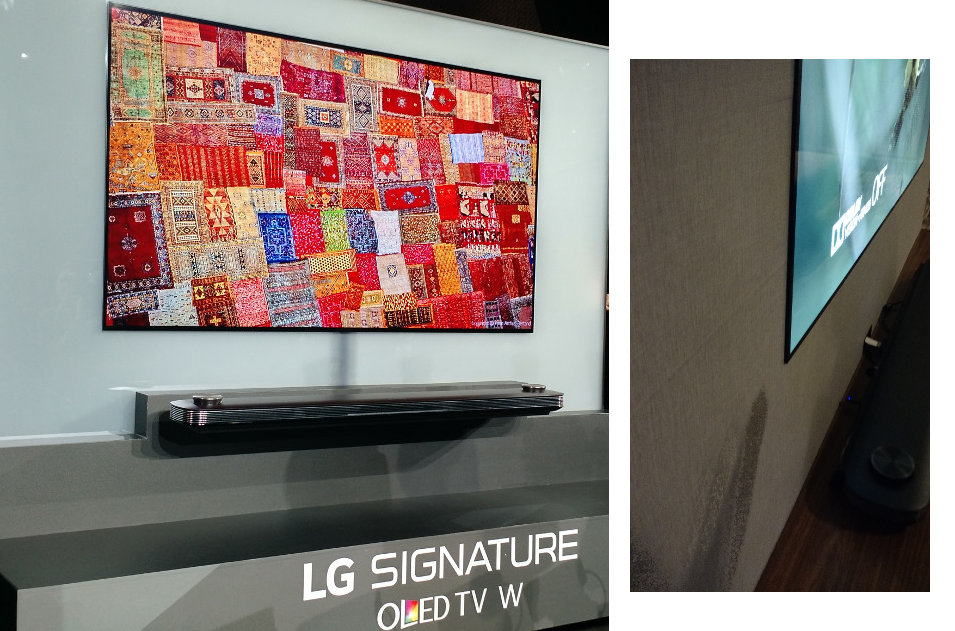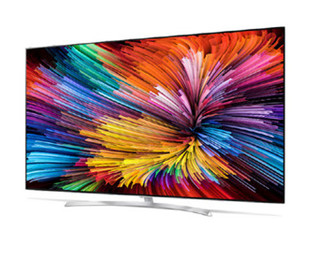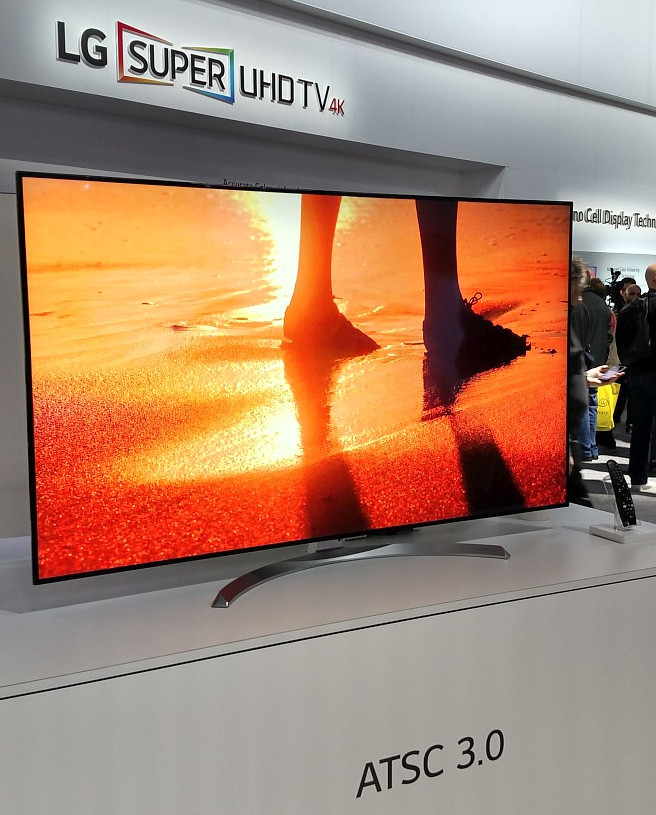LG, like Samsung, showcased a variety of technologies and products at CES 2017. We attended their press conference, invite-only innovation room and their booth on the show floor to gather details. The highlights to be discussed include:
- Wallpaper 4K OLED TV and other models
- Super UHD LCD TVs
- Improved viewing angles
- Technicolor partnership
- ATSC 3.0 integration
- Dolby Vision and Atmos integration
- Nano Cell / Nano Color Technology (covered elsewhere)
Wallpaper TV is AMAZING
Perhaps the most TV buzz at CES was about LG’s new Signature OLED TV called the W7. This is a flexible, super thin high performance TV that earned the nickname of “wallpaper TV” – and deservedly so. It is only 2.57 mm thick – that’s less than half the thickness of most smartphones! The electronics are housed in a separate soundbar/controller that sits below the TV and feature up-firing, pop up speakers with Dolby Atmos support. Content is delivered over a custom, flat, cable. The TV mounts to the wall with magnets so there is no gap between TV and wall. The 77” version won a CES Best of Innovation Award.

Overall, LG is offering 10 OLED TVs for 2017 including the W7 (65” and 77”) G7 (65” and 77”), E7 (55” and 65”) the C7 (55” and 65”) and the B7 (55” and 65”). LG describes these models as the, “blade-slim B7 and C7 series, Picture-on-Glass E7 and G7 series, and the Picture-on-Wall W7 series.”
All 2017 TVs will feature Dolby Vision and Atmos, HLG, HDR10 and Advanced HDR by Technicolor. This is clearly the most comprehensive support from any of the TV makers. In addition, LG says it will enhance the HDR performance on content on a frame-by-frame basis when the content only has static metadata (HDR10) or no metadata at all (HLG). This is called “Active HDR” and apparently works in conjunction with the Dolby Vision processor. LG is also ready to support Advanced HDR by Technicolor as well, when content with this encoding starts to flow. There will also be an SDR-to-HDR upconverter called “HDR Effect.”
In terms of picture performance, image quality is stellar. While the OLED sets are never going to win the luminance war with LCD, the ability to display a bright pixel next to a black pixel with extremely high contrast is a feature that LCDs will never match. This gives the set the best “pop” possible.
LG Electronics does not like to provide luminance or color gamut information. However, in the LG Display Innovation Room, we saw a sign that noted the color gamut and luminance levels of the 77” wallpaper display. Luminance was listed as 800/500/150 cd/m² for average picture levels of 10/25/100%, respectively That’s about a 25% increase over last year’s panel luminance. The color gamut was listed a 99/129/93% of DCI-P3/sRGB (709)/NTSC. This is also a small increase over previous performance levels.
Detailed pricing and availability for the LG OLED TVs is not set other than to note that the majority of TVs will arrive at retail between the end of March and the middle of April. Best Buy is showing the 65” W7 available for pre-order for $8K, the same price as today’s G6 model.
New Super UHD TVs
LG Electronics introduced three new Super UHD LCD TVs at CES 2017: the SJ9500, SJ8500 and SJ8000. The most highly touted feature of these sets is the new Nano Cell technology, which is apparently not a quantum dot solution, but is said to, “boosts black and luminance levels, widen the color gamut, and exceed quantum-dot off-axis color accuracy, delivering accurate color at viewing angles up to 60 percent.” (see LG: “We don’t need no stinking quantum dots.”)
They will all feature HDR10, Dolby Vision, HLG and Advanced Technicolor HDR for native HDR decoding – like their OLED cousins. They will also get the Active HDR technology which processes HDR10 and HLG content to adjust the tone mapping on a frame-by-frame basis to improve the experience.

The 2017 Super LCD models feature an “Ultra Slim” (only 6.9 mm at thinnest point on a 55” model) design with a crescent-shaped stand.
Reflectivity is also minimized to maintain high picture quality in environments with ambient lighting, LG said.
The SJ9500 and SJ8500 series use a conventional RGB stripe sub-pixel pattern while the SJ8000 series use LG’ M+ panel which has RGBW sub-pixels (like the OLED panels). Details on luminance and color gamut are not published by LG Electronics, but a color gamut of “over 90% of P3” was mentioned in the press conference referring to the flagship Super LCD models.
Super LCD model sizes have been announced, but not prices yet. All should arrive at retail in April.
- SJ9570 86”
- SJ9500 65”
- SJ8570 75”
- SJ8500 65”, 55”
- SJ8000 65”, 55”
Other LCD TVs
LGE will offer three other series in 2017 of LED LCD TVs – all with UHD resolution using the M+ RGBW panels. All will support HDR10 and HLG inputs as well.
The UJ6300 series will come in 43”, 49”, 55”, 60” and 65” and is the entry level UHD platform. It includes the SDR-to-HDR upconversion technology HDR Effect but does not have wide color gamut or expanded luminance.
The step-up UJ6570 series has the same features as the UJ6300 but in larger screen sizes of 70 and 75 inches. They get a new model name as the styling is a bit different and the color gamut is expanded a little with some local dimming control.
The UJ7700 series is the bridge to the Super LCD series and is offered in 49”, 55”, 60” and 65” sizes. This adds Dolby Vision but not the Nano Cell technology. The 65” comes with a Magic remote as well.
All will arrive in the late March-April time frame.
First TVs to Support Dolby Vision and Atmos
It seems strange that no one has done it before, but LG used CES 2017 to become the first TV maker to package Dolby Vision and Dolby Atmos into a standalone TV. The combination of technologies will be implemented across the full line of LG 4K OLED TVs for 2017.
Apparently, HDMI 2.0 is not designed to support Atmos so LG and Dolby had to be clever. They solved the problem by passing Dolby Atmos metadata through the TVs’ HDMI 2.0a audio return channel (ARC).
The signaling and data carriage of Dolby Atmos audio is part of the new HDMI 2.1 specification unveiled at CES 2017, but that specification won’t be finalized until June and who knows when silicon supporting the standard will roll out. Dolby and LG didn’t want to wait, so they tweaked the HDMI 2.0 interface to use ARC for this purpose (probably using the same technique that will be in 2.1).
According to a written statement from Dolby on this question, we received this: “Dolby Atmos is compatible with many Dolby audio formats, including Dolby Digital Plus, Dolby AC-4 and Dolby TrueHD. In addition, Dolby Atmos PCM objects can be carried in the proprietary MAT format for transmission over HDMI, which is how XBox One and Windows 10 devices will send Dolby Atmos audio to Atmos compatible sink devices. For Dolby Digital Plus, Dolby Atmos support is backwards compatible with a standard 5.1-ch mix. This means the same Dolby Atmos signal can be rendered both on a Dolby Atmos system as well as a standard 5.1-ch audio system.”
In addition to this combined experience, all LG’s flagship Super UHD TVs will continue to support Dolby Vision in 2017 (without Dolby Atmos). This includes the SJ9500, SJ8500, and JS800 Super UHD TVs, which will be available globally.
More than 80 studio titles are available in Dolby Vision, and more than 100 titles are available in Dolby Atmos, with 25 available in both formats. Most major US studios, including Warner Bros. Home Entertainment and Universal Pictures Home Entertainment, have announced support to deliver Dolby Vision titles and Dolby Atmos titles. Additionally, more than 100 hours of original content is available in Dolby Vision across leading OTT providers globally, and soon consumers will have access to Dolby Vision titles on Ultra HD Blu-ray disc, with anticipated availability in 2017, the company said.
First TVs with ATSC 3.0 Tuners for Korea
 Not all of the components of the new ATSC 3.0 transmission standard are finalized yet – including which HDR and dynamic metadata formats will be supported – yet LG Electronics got out ahead of the decisions announcing 4K TVs for 2017 that will include ATSC 1.0 and 3.0 tuners. The sets will go on sale in Korea first starting this spring in advance of the 2018 Winter Olympics, scheduled for Korea.
Not all of the components of the new ATSC 3.0 transmission standard are finalized yet – including which HDR and dynamic metadata formats will be supported – yet LG Electronics got out ahead of the decisions announcing 4K TVs for 2017 that will include ATSC 1.0 and 3.0 tuners. The sets will go on sale in Korea first starting this spring in advance of the 2018 Winter Olympics, scheduled for Korea.
A demonstration of ATSC 3.0 transmitted content was made at CES on sets operated by LG and Samsung. The LG set was a 65-inch model that showed HDR UHD content. Presumably, this was encoded as HDR10, but new LG sets can decode HLG and Dolby Vision signals as well. LG also demonstrated ATSC 3.0’s advanced electronic service guide capabilities.
ATSC 3.0 is based on Internet Protocol and includes a broadcast and a broadband component allowing flexibility and new options for broadcasters. It is also optimized for mobile reception, including in fast moving vehicles. LG has been particularly active in ATSC standards development since before HDTV (ATSC 1.0) was introduced via its US R&D lab, Zenith. (for more see Next Generation Broadcast TV Platform Coming Soon)
LG Home Entertainment Company president Brian Kwon noted that, “Early availability of ATSC 3.0 products in Korea also sets the stage to support U.S. broadcasters’ Next-Gen TV rollout plans in 2018 and beyond.”
Technicolor Partnership
LG is working with Technicolor on two fronts. One is to add decoding of the Advanced HDR by Technicolor distribution format that is currently being considered by several standards bodies including ATSC. It has already been approved as one of the four methods to carry dynamic metadata in SMPTE ST-2094. In addition, the two are working to add a Technicolor Expert Mode to the OLED TVs as well as the Super LCD TVs in 2017.
Advanced HDR by Technicolor (they need a better name) is a production and distribution format that allows cameras to capture content in HDR using HLG, PQ or even camera-specific gamma curves that are optimized for those sensors, like Sony sLog3. A production can even mix in SDR cameras. These are all converted to a common format for production and at the final encoder, they are formatted as a single stream with metadata that can playout on HDR or SDR sets. (see Technicolor Talks HDR & VR at CES 2017 for more on this)
Technicolor has also now selected LG to provide the new OLED Signature TV as reference displays in their production suites worldwide. These will not be color grading monitors, but test TVs to validate the fidelity of the image reproduction through the whole distribution chain.
OS, UI and Content Access Updates
LG will continue to use its latest webOS platform (version 3.5) which will facilitate access to OTT content, including HDR content. LG has partnered with leading digital content providers such as Amazon, Netflix and Vudu. In its booth at CES, LG showed HLG programming from DIRECTV, Dolby Vision content from Netflix and HDR10 titles from Amazon Prime Video.
LG’s new webOS 3.5 smart TV platform keeps all of the features of last year’s system, which has had good reviews, but adds easier control and faster access when using the improved Magic Remote and the new Magic Link feature, LG said. Viewers can access a content provider by pressing a single button on the remote.
The new Magic Link capability for example, provides recommendations for finding your favorite content and accessing information about actors and characters on-screen. An enhanced Magic Zoom feature now lets viewers enlarge and record any part of the screen to see close ups.
LG was also showcasing Channel Plus – a free service powered by Xumo and available on LG’s webOS smart TVs beginning in 2016. Channel Plus integrates 70+ free streaming digital channels including sports and news from national broadcast networks such as Fox Sports, Newsy, Sports Illustrated, TIME, Bloomberg, People, Funny or Die, Fail Army and more into your existing over-the-air TV channel options.
Connecting the TV to a mobile phone or PC with a USB cable allows one to enjoy 360-degree VR content as well. – CC
Other LG news from CES is in a separate article.

